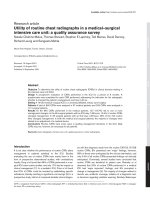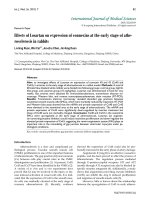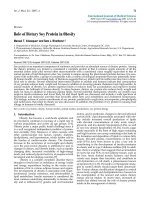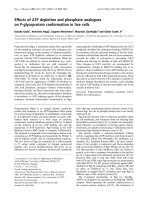Báo cáo y học: "Effects of p-Synephrine alone and in Combination with Selected Bioflavonoids on Resting Metabolism, Blood Pressure, Heart Rate and Self-Reported Mood Changes"
Bạn đang xem bản rút gọn của tài liệu. Xem và tải ngay bản đầy đủ của tài liệu tại đây (588.27 KB, 7 trang )
Int. J. Med. Sci. 2011, 8
295
I
I
n
n
t
t
e
e
r
r
n
n
a
a
t
t
i
i
o
o
n
n
a
a
l
l
J
J
o
o
u
u
r
r
n
n
a
a
l
l
o
o
f
f
M
M
e
e
d
d
i
i
c
c
a
a
l
l
S
S
c
c
i
i
e
e
n
n
c
c
e
e
s
s
2011; 8(4):295-301
Research Paper
Effects of p-Synephrine alone and in Combination with Selected Bioflavo-
noids on Resting Metabolism, Blood Pressure, Heart Rate and Self-Reported
Mood Changes
Sidney J. Stohs
1
, Harry G Preuss
2
, Samuel C. Keith
3
, Patti L. Keith
3
,
Howard Miller
4
, Gilbert R. Kaats
3
1. Dean Emeritus, Creighton University Health Sciences Center, Omaha, NE 68178, USA
2. Department of Physiology, Georgetown University Medical Center, Washington, DC, USA
3. Integrative Health Technologies, Inc., 4940 Broadway, San Antonio, TX 78209, USA
4. Nutratech Inc., West Caldwell, NJ 07006, USA
Corresponding author: Harry G. Preuss, M.D., , phone: 1-202-687-1441
© Ivyspring International Publisher. This is an open-access article distributed under the terms of the Creative Commons License (
licenses/by-nc-nd/3.0/). Reproduction is permitted for personal, noncommercial use, provided that the article is in whole, unmodified, and properly cited.
Received: 2011.02.02; Accepted: 2011.03.06; Published: 2011.04.28
Abstract
Bitter orange (Citrus aurantium) extract is widely used in dietary supplements for weight
management and sports performance. Its primary protoalkaloid is p-synephrine. Most studies
involving bitter orange extract and p-synephrine have used products with multiple ingredients.
The current study assessed the thermogenic effects of p-synephrine alone and in conjunction
with the flavonoids naringin and hesperidin in a double-blinded, randomized, place-
bo-controlled protocol with 10 subjects per treatment group. Resting metabolic rates (RMR),
blood pressure, heart rates and a self-reported rating scale were determined at baseline and
75 min after oral ingestion of the test products in V-8 juice. A decrease of 30 kcal occurred in
the placebo control relative to baseline. The group receiving p-synephrine (50 mg) alone
exhibited a 65 kcal increase in RMR as compared to the placebo group. The consumption of
600 mg naringin with 50 mg p-synephrine resulted in a 129 kcal increase in RMR relative to the
placebo group. In the group receiving 100 mg hesperidin in addition to the 50 mg p-synephrine
plus 600 mg naringin, the RMR increased by 183 kcal, an increase that was statistically sig-
nificant with respect to the placebo control (p<0.02). However, consuming 1000 mg hes-
peridin with 50 mg p-synephrine plus 600 mg naringin resulted in a RMR that was only 79 kcal
greater than the placebo group. None of the treatment groups exhibited changes in heart rate
or blood pressure relative to the control group, nor there were no differences in
self-reported ratings of 10 symptoms between the treatment groups and the control group.
This unusual finding of a thermogenic combination of ingredients that elevated metabolic rates
without corresponding elevations in blood pressure and heart-rates warrants longer term
studies to assess its value as a weight control agent.
Key words: p-Synephrine, naringin, hesperidin, resting metabolic rate, heart rate, blood pressure
Introduction
The bioflavonoids hesperetin and naringenin are
widely distributed in citrus fruits and juices as their
glycosides, hesperidin and naringin, respectively.
They are present in Citrus aurantium as well as a wide
variety of other Citrus species [1]. The sugar moieties
for both flavonoids consist of rhamnose plus glucose,
which must be removed in the intestinal tract before
the flavonoids can be absorbed [2, 3]. The absorption
Int. J. Med. Sci. 2011, 8
296
of these flavonoids in human subjects has been exten-
sively studied and depends in part upon the forms in
which they are ingested (juice or fruit, glycoside or
aglycone, capsule, tablet, etc.) [4-8].
Experiments involving human subjects, animals
and cell culture systems have shown that the two
flavonoids exhibit a wide range of potentially benefi-
cial physiological and biochemical effects. Naringen
and/or hesperidin or their aglycones have been
shown to improve insulin sensitivity and glucose tol-
erance [9], prevent accumulation of triglycerides [9],
inhibit cholesterol biosynthesis [10, 11], and serve as
antioxidants and anti-inflammatory agents [12, 13] as
well as hepatoprotectants [14] and neuroprotectants
[15]. However, the effects of naringin and hesperidin
on metabolic rate and energy utilization have not been
previously assessed.
Studies have suggested that p-synephrine has
thermogenic and lipolytic activities [16-18], increasing
energy metabolism [19, 20] as well as athletic perfor-
mance [21]. p-Synephrine is the primary protoalkaloid
in bitter orange extract which is derived from the
immature fruits of Citrus aurantium [22-25], and is
widely distributed in other Citrus species [22, 23, 26].
The safety of p-synephrine and bitter orange extract
has recently been reviewed [27], and based on the
available studies in animals, humans and cell culture
systems, it has been concluded that when taken orally
and in recommended amounts both are safe.
p-Synephrine is widely used in combination with
caffeine and other ingredients in products designed to
support weight management [19, 28]. However, no
studies have been reported comparing the thermo-
genic effects of p-synephrine when combined with the
flavonoids hesperidin and naringin. This pilot study
was designed to examine these effects using a com-
parative effectiveness research (CER) study design
[29] in a double-blinded, randomized, place-
bo-controlled protocol to compare the effects of
p-synephrine alone and in combination with different
amounts of hesperidin and naringin on: (1) resting
metabolism, (2) blood pressure, (3) resting heart-rate,
and (4) self-reported mood/energy levels in healthy
human subjects.
Material and methods:
A total of 50 participants gave written informed
consent in compliance with the Helsinki Declaration
and approved by Integrative Health Technologies’
Ethics Committee. Participants fasted for 8-10 hours
without consuming caffeinated beverages, nicotine,
exercising or participating in vigorous physical activ-
ities. Upon reporting to the research center, partici-
pants completed the 10-item self report in Table 1.
After remaining seated in an isolated area for
10-15 min., participants completed measurements of
their blood pressure, resting heart-rate and resting
metabolism using Micro Life’s MedGem® Indirect
Calorimeter (Microlife Medical Home Solutions,
Golden, CO. 80401). The MedGem® is a hand-held,
self-calibrating calorimeter that measures oxygen
consumption (VO2) to determine resting metabolic
rate (RMR). In conjunction with the study, test-retest
reliabilities of the instrument were measured on 41
subjects from test-retest periods ranging from 1-17
days between tests. The average reliability coefficient
was 90.2 %, a coefficient that was consistent over the
four test-retest periods.
p-Synephrine was administered in the form of
the patented bitter orange extract Advantra Z
®
which
contained 60 % of this active material. Naringin and
hesperidin were 96 % pure. All test materials were
obtained from Nutratech Inc. (West Caldwell, NJ).
Table 1. Self Ratings Completed at Baseline, 45 and 75 minutes.
Int. J. Med. Sci. 2011, 8
297
Subsequent to RMR measurements, participants
were randomly assigned to one of the five dou-
ble-blinded treatment conditions in which they con-
sumed one ounce of V-8 juice containing the following
ingredient variations:
Group 1: Placebo (V-8 juice only)
Group 2: Advantra Z
®
(50 mg of p-synephrine)
Group 3: Advantra Z
®
with 0 mg hesperidin and
600 mg naringin
Group 4: Advantra Z
®
with 100 mg hesperidin
and 600 mg naringin
Group 5: Advantra Z
®
with 1,000 mg hesperidin
and 600 mg naringin
After remaining seated and resting for 45 min.,
participants completed a second self report rating
scale. After 75 min., a third and final self report rating
scale was completed, and measurements of blood
pressure, heart-rate and RMR were determined.
Statistical Analyses
ANOVAs were calculated between the groups’
baseline, ending and change scores for each treatment
group in addition to Dunnett’s t-test between each of
the treatment groups and the placebo group.
Results
Figure 1 shows the changes in resting metabolic
rates (RMRs) from baseline expressed as kcals for each
of the treatment groups (N=10 per group). As ex-
pected, a small decrease occurred in the RMR of the
placebo group since these participants continued their
8-10 hour fast (Group1). Increases occurred in the
RMR of all treatment groups. As compared to place-
bo, 50 mg p-synephrine (Advantra Z
®
) alone (Group
2) more than doubled consumption by 65 kcals over
placebo. In Group 3, adding 600 mg naringin to the 50
mg p-synephrine further increased calorie consump-
tion more than three-fold to 122 kcals over placebo.
The addition of 100 mg hesperidin to the p-synephrine
plus naringin in Group 4 resulted in a further increase
in calorie consumption by 5-fold to 183 kcal over pla-
cebo. However, in Group 5, when the amount of hes-
peridin consumed in conjunction with the 50 mg
p-synephrine plus 600 mg naringin was increased to
1000 mg, the increase in calorie consumption over
placebo was only 79 kcal, an increase between calorie
consumption in the absence of hesperidin and in the
presence of 100 mg hesperidin.
Figure 1. Over-Placebo Comparisons of Changes in Resting Metabolic Rates 75 Minutes from Baseline (Expressed in kcal)
With a Supplement Containing the Variations in Advantra Z, Naringin, and Hesperidin
Int. J. Med. Sci. 2011, 8
298
In spite of the low levels of statistical power in
these groups of only 10 subjects, the increases in RMR
in Group 4 was significantly greater than placebo
(P=0.039) and Advantra Z alone (Group 2). It is also
worth noting the a repeated-measures Students’ t-test
revealed that the changes from baseline in Group 3
and Group 4 were both statistically significant
(P=0.001 and 0.030, respectively).
Table 2 shows changes in blood pressures and
resting heart-rates from baseline to the ending test for
each of the five study groups. The average baseline
blood pressures and resting heart-rates for the study
cohort were well within the normal ranges of 121/74
mm Hg and 70 BPM. At the conclusion of the study
(75 min.), no increases in either systolic or diastolic
blood pressures or heart rate were observed. None of
the baseline-ending changes approached statistical
significance nor were there any statistically significant
differences between any of the five study groups.
Table 3 depicts the results of the self-report rat-
ings for the 10 symptoms. As compared to the placebo
group, none of the changes in these 10 self-reported
symptoms were statistically significant either 45 or 75
min. from baseline. No significant effects relative to
the placebo group were observed by the participants
in the four treatment groups for symptoms including
anxiety, hunger, tension, sleepiness, energy, nerv-
ousness, headache, upset stomach, concentration or
general discomfort.
Table 2. Blood Pressures and Resting heart Rates
Treatment
Variable
Placebo T2 T3 T4 T5 P-Value
1
SYSTOLIC
Baseline 122.9(17.7) 120.5(14.5) 120.0(12.3) 117.9(14.4) 125.6(12.6) 0.794
Ending 123.3(18.3) 120.3(9.0) 120.9(11.4) 119.3(15.5) 130.8(10.2) 0.317
DIASTOLIC
Baseline 71.3(6.9) 73.8(6.4) 77.0(6.3) 72.7(9.8) 76.9(6.4) 0.316
Ending 75.0(9.1) 74.6(8.3) 75.5(10.0) 71.8(10.0) 75.3(7.8) 0.891
HEART RATE
Baseline 64.5(11.2) 72.3(5.1) 70.0(14.0) 71.6(13.3) 69.4(6.4) 0.518
Ending 62.7(9.4) 71.6(6.7) 65.7(9.0) 68.6(9.5) 68.0(8.4)
0.206
1
ANOVA. Placebo: V-8 juice only, T2: 50 mg of p-synephrine (Advantra Z
®
). T3: p-synephrine + 600 mg naringin. T4: p-synephrine + 600 mg
naringin + 100 mg hesperidin. T5: p-synephrine + 600 mg naringin + 1,000 mg hesperidin. Each value is the mean with the standard devia-
tion for 10 subjects.
Table 3. Mean changes from baseline in each rating for placebo and each treatment group with p values for between groups
comparisons between placebo and treatment groups.
Int. J. Med. Sci. 2011, 8
299
Discussion
Using a double-blinded, randomized, place-
bo-controlled protocol, this study compared the ef-
fects of 50 mg p-synephrine (as Advantra Z
®
) alone
with three different amounts of hesperidin and nar-
ingin on: (1) resting metabolism rate, (2) blood pres-
sure, (3) resting heart-rate, and (4) self-reported
mood/energy levels in healthy human subjects. As
expected, the RMR of the placebo group decreased
over the 75 min. test-retest period since subjects con-
tinued the 8-10 hour fast they began prior to the start
of the study (Figure 1). The addition of p-synephrine,
hesperidin, and naringin led to increases in RMR over
placebo. However, while adding 100 mg of hesperidin
in Group 4 led to an increase in RMR over placebo, an
unexpected reduction was observed in the RMR in
Group 5 which received 1000 mg hesperidin as com-
pared to Group 4. These data indicate that increasing
the hesperidin from 100 mg to 1,000 mg reversed
some of the thermogenic effects of 100 mg hesperidin
in combination with 50 mg p-synephrine plus 600 mg
naringin. It may be that in this case, more is not better,
and increasing the amount of hesperidin constitutes
an example of hormesis [30, 31].
The increase in the metabolic rate between
p-synephrine alone and the placebo control was ap-
proximately 6.9 %. This increase in thermogenesis is
similar to the increases reported in previous studies
involving p-synephrine [17, 18]. The increase in RMR
between Group 4, the combination of p-synephrine
with 600 mg naringin and 100 mg hesperidin, and the
placebo control is approximately 17.7 %. If one as-
sumes that the product was taken twice a day for one
year, the theoretical increase in calorie consumption
would amount to over 31 pounds. However, the ac-
tual extent of weight loss if the product was con-
sumed under these conditions remains to be deter-
mined.
The mechanism by which naringin and hesperi-
din increase the thermogenic effect of p-synephrine
may involve enhancing the expression of adiponectin
which is known to play a role in lipid and glucose
metabolism. Liu et al. [32] have shown that
naringenin and hesperetin up-regulate adiponectin
expression, and both activate the peroxisome prolif-
erator-activated receptor-γ (PPARγ) which has been
recognized as the master regulator of adipocyte dif-
ferentiation. In addition, naringenin also possessed
significant ability to activate PPARα [32], a major
regulator of lipid metabolism in the liver.
Products with thermogenic properties are fre-
quently associated with elevated blood pressures and
heart-rates. p-Synephrine is a phenylethylamine de-
rivative with some structural similarities to ephed-
rine, and is thus assumed to exert cardiovascular ef-
fects by many authors [see for example, 20, 21, 33-35].
However, no effects on heart rate or blood pressure
were observed in response to p-synephrine or
p-synephrine in combination with naringin and hes-
peridin (Table 2). p-Synephrine differs from ephedrine
in that it has a hydroxyl group on the para position of
the benzene ring and lacks the methyl group on the
side chain of the molecule. These structural differ-
ences greatly alter the pharmacokinetic and receptor
binding properties of p-synephrine, resulting in little
or no cardiovascular effects [27], as confirmed by this
study. No adverse events have been directly at-
tributable to bitter orange extract and p-synephrine
[36, 37]. However, caffeine is commonly present in
products that contain p-synephrine [19, 28], and is
well known to produce cardiovascular effects [38],
particularly in caffeine-sensitive individuals [39].
The absence of changes in blood pressure, rest-
ing heart-rate and self-ratings in the four treatment
groups involving p-synephrine, naringin and hes-
peridin relative to the placebo group is very positive,
and in conjunction with the increased thermogenesis
may result in the development of beneficial products
with respect to weight loss and weight management.
The findings were further substantiated by con-
sistency of the results across all four treatment groups.
However, longer term studies are required to assess
the amount of weight that is actually lost in response
to these products, and to provide information con-
cerning safety when used over an extended period of
time.
A problem faced in studies of thermogenic ef-
fects is that noticeable changes in the mood states
listed in Table 1 often make subjects aware of whether
or not they are receiving a placebo, thus undermining
blinding of the study. The lack of significant differ-
ences between the treatment groups and the control
group with respect to the self-report ratings of symp-
toms increases confidence in the safety of the combi-
nation as well as in the blinding procedure used in
this study.
Strengths of the study are the use of randomized
placebo-controlled double-blinded study design, the
absence of thermogenic changes in the placebo group,
the absence of adverse effects on blood pressure,
heart-rate and self-reports in the four treatment
groups, the consistency of the effects of p-synephrine
on metabolism in all treatment groups, and the in-
creases in RMR in the treatment groups. The weak-
ness of this study is the small number (10) of subjects
in the placebo and in each of the treatment groups.
The study also reveals an interesting effect with re-









